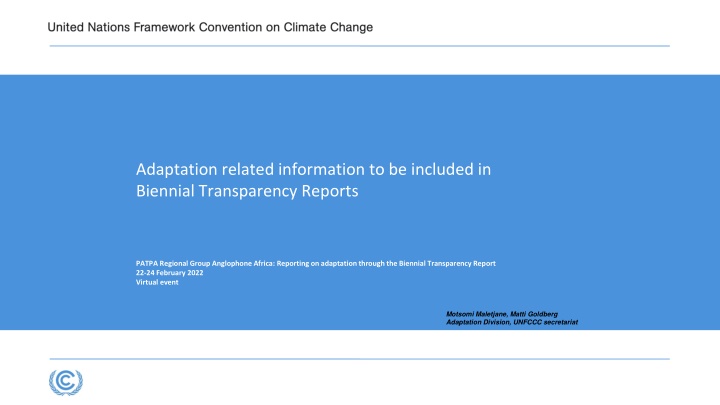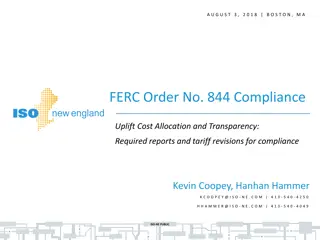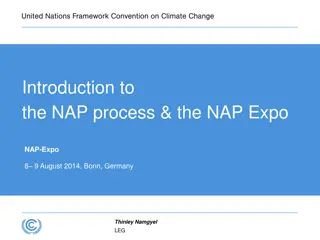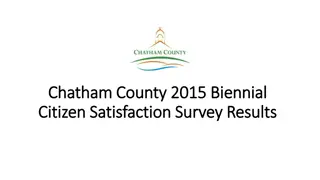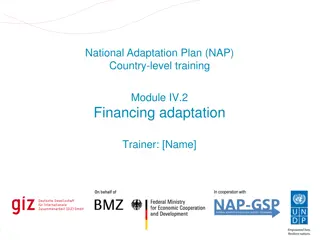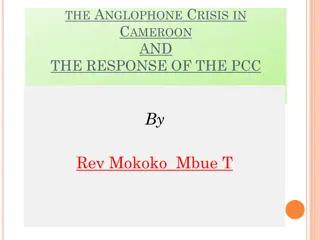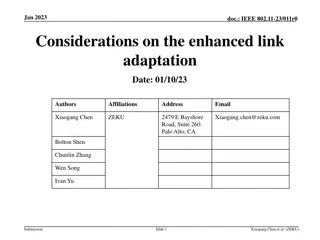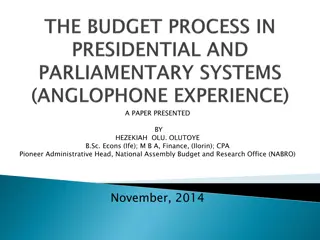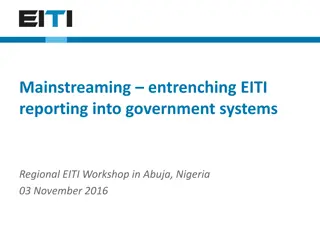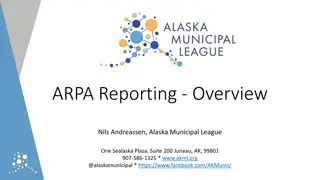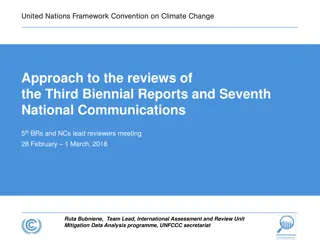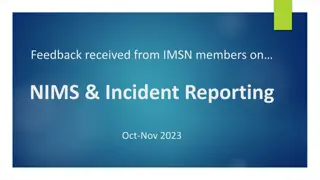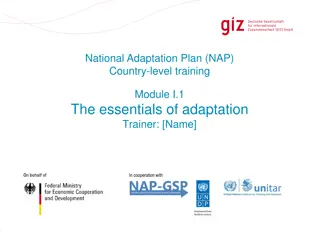Reporting on Adaptation in Biennial Transparency Reports: Insights from Anglophone Africa
Explore the integration of adaptation-related information in Biennial Transparency Reports for Anglophone Africa, presented during a virtual event. Learn about key guidelines, criteria, and potential synergies between National Adaptation Plans and Biennial Transparency Reports to enhance effectiveness in adaptation planning. Discover the importance of comprehensiveness and inclusiveness in addressing risks, impacts, hazards, and vulnerabilities for successful adaptation strategies.
Download Presentation

Please find below an Image/Link to download the presentation.
The content on the website is provided AS IS for your information and personal use only. It may not be sold, licensed, or shared on other websites without obtaining consent from the author.If you encounter any issues during the download, it is possible that the publisher has removed the file from their server.
You are allowed to download the files provided on this website for personal or commercial use, subject to the condition that they are used lawfully. All files are the property of their respective owners.
The content on the website is provided AS IS for your information and personal use only. It may not be sold, licensed, or shared on other websites without obtaining consent from the author.
E N D
Presentation Transcript
Adaptation related information to be included in Biennial Transparency Reports PATPA Regional Group Anglophone Africa: Reporting on adaptation through the Biennial Transparency Report 22-24 February 2022 Virtual event Motsomi Maletjane, Matti Goldberg Adaptation Division, UNFCCC secretariat
UNFCCC arrangements involving adaptation information REPORTING AND COMMUNICATION WITH ADAPTATION-SPECIFIC GUIDELINES NC portal 1999: National communications of annex I Parties (FCCC/CP/1999/7) 2019: new guidelines (6/CP.25) NC portal 2002: National communications of non-annex I Parties (17/CP.8) 2015/2018: ADCOMs (PA Art 7 + 9/CMA.1) Public registry 2015/2018: BTRs (PA Art 13 + 18/CMA.1) UNFCCC website NATIONAL-LEVEL ADAPTATION PROCESSES WITH REPORTING / COMMUNICATION ASPECTS 2001: NAPAs UNFCCC website NAP Central 2010: NAPs (5/CP.17) OTHER DOCUMENTS CONTAINING ADAPTATION INFORMATION 2014: Adaptation components of INDCs/NDCs (1/CP.20) NDC registry UNFCCC website Low-emission dev. strategies (PA Art 4.19) 2
Criteria to assess adequacy and effectiveness in adaptation planning (UNEP, 2020 & 2021) Criteria Indicators Comprehensiveness Adaptation options comprehensively address assessed risks, impacts, hazards or vulnerabilities Inclusiveness Dedicated stakeholder engagement process in place Consideration of gender Implementability Presence of Central administrative body Regulations Investments Incentives Integration Presence of Sectoral adaptation plans and coordination mechanisms Subnational adaptation plans and coordination mechanisms Monitoring and evaluation M&E system in place Monitoring/Progress report published Evaluation undertaken and report published 4
Comprehensiveness Adaptation options comprehensively address assessed risks, impacts, hazards or vulnerabilities The NAP summarizes assessment of impacts, vulnerability and risk, including a baseline Presents adaptation priorities using multiple lenses (hazards, sectors, admin levels, scale, etc.); Provides, in a transparent manner, the criteria used for ranking systems, vulnerabilities and risks, and adaptation options Chad (2022) 5
Inclusiveness Stakeholder engagement; consideration of gender; etc. The NAP serves as the national policy instrument for coordinating and driving actions of all actors and stakeholdersin pursuit of adaptation goals and outcomes; Stakeholders are engaged throughout the process from laying the groundwork and addressing gaps; assessments; implementation strategies; reporting, monitoring and review; Example: Countries are increasingly engaging the full diversity of actors and stakeholders e.g. majority of the NAPs submitted by the developing countries explicitly address gender and women (UNFCCC LDC Expert Group, 2021) 6
Implementability Central administrative body; Regulations; Investments; Incentives The NAP serves as a repository of adaptation actions such as through projects seeking support and financing to investors including the private sector and bilateral programmes; Provides details on leadership and coordination arrangements; institutional, legal and regulatory frameworks guiding adaptation The NAP would include adequate details to facilitate swift development and approval of projects and programmes for implementation of adaptation measures; Alignment of priority activities with the GCF country programme for the country Timor-Leste (2021) 7
Integration Sectoral and subnational adaptation plans and coordination mechanisms The NAP serves as the umbrella plan of action for adaptation for the country, embracing all other relevant national plans, sectoral strategies and plans at various subnational levels and where relevant, regional/transboundary plans; It serves to manage coherence and synergy of climate change adaptation efforts with national development, SDGs, Sendai Framework, other intl., regional and national frameworks; Example: integration into sectoral strategies; budget coding; integration of vulnerable groups, indigenous peoples, etc.; (UNFCCC LDC Expert Group, 2021) In the formulation of County Adaptation Plans, counties will be encouraged to identify their priority actions from the actions presented herein and customisethem to suit their county context after conducting risk/vulnerability assessments. Kenya (2017) 8
Monitoring and evaluation M&E system in place; Monitoring/Progress report published; Evaluation undertaken; report published The NAP would clearly state goals, objectives and where possible, concrete targets to guide application of appropriate M&E systems in the future It would provide a baseline of vulnerability, and give regular updates on vulnerability to inform assessment of progress in adaptation in relation to the global temperature goal of <2 C and the global goal on adaptation 9
Motsomi Maletjane Team Lead, Adaptation Committee Unit Adaptation Division E-mail: mmaletjane@unfccc.int Thank you
